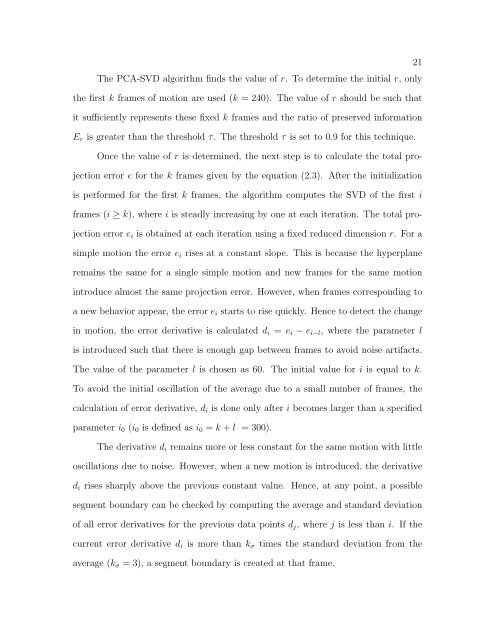A COMPARISON AND EVALUATION OF MOTION INDEXING ...
A COMPARISON AND EVALUATION OF MOTION INDEXING ...
A COMPARISON AND EVALUATION OF MOTION INDEXING ...
Create successful ePaper yourself
Turn your PDF publications into a flip-book with our unique Google optimized e-Paper software.
The PCA-SVD algorithm finds the value of r. To determine the initial r, only<br />
the first k frames of motion are used (k = 240). The value of r should be such that<br />
it sufficiently represents these fixed k frames and the ratio of preserved information<br />
Er is greater than the threshold τ. The threshold τ is set to 0.9 for this technique.<br />
Once the value of r is determined, the next step is to calculate the total pro-<br />
jection error e for the k frames given by the equation (2.3). After the initialization<br />
is performed for the first k frames, the algorithm computes the SVD of the first i<br />
frames (i ≥ k), where i is steadly increasing by one at each iteration. The total pro-<br />
jection error ei is obtained at each iteration using a fixed reduced dimension r. For a<br />
simple motion the error ei rises at a constant slope. This is because the hyperplane<br />
remains the same for a single simple motion and new frames for the same motion<br />
introduce almost the same projection error. However, when frames corresponding to<br />
a new behavior appear, the error ei starts to rise quickly. Hence to detect the change<br />
in motion, the error derivative is calculated di = ei − ei−l, where the parameter l<br />
is introduced such that there is enough gap between frames to avoid noise artifacts.<br />
The value of the parameter l is chosen as 60. The initial value for i is equal to k.<br />
To avoid the initial oscillation of the average due to a small number of frames, the<br />
calculation of error derivative, di is done only after i becomes larger than a specified<br />
parameter i0 (i0 is defined as i0 = k + l = 300).<br />
The derivative di remains more or less constant for the same motion with little<br />
oscillations due to noise. However, when a new motion is introduced, the derivative<br />
di rises sharply above the previous constant value. Hence, at any point, a possible<br />
segment boundary can be checked by computing the average and standard deviation<br />
of all error derivatives for the previous data points dj, where j is less than i. If the<br />
current error derivative di is more than kσ times the standard deviation from the<br />
average (kσ = 3), a segment boundary is created at that frame.<br />
21
















